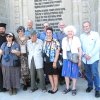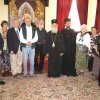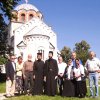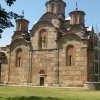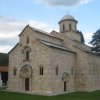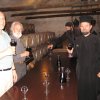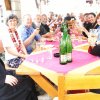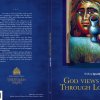The richness of the total experience of this pilgrimage is beyond expression, and I apologize in advance to my fellow pilgrims if my words inevitably fall short of the fullness and brightness of what is undoubtedly etched in your memories. This pilgrimage was a success because it succeeded in being, for each of us, what it was intended to be, namely, true pilgrimage. But a journey to distant lands and to monasteries and holy places, even if called a “pilgrimage”, does not automatically transform itself into a true pilgrimage. In our contemporary world, dominated by virtualizing technology and overwhelmed with information, words, especially religious words like “pilgrimage” and “community”, often become debased and lose their true meaning. To understand what true pilgrimage is, the difficulty of attaining it in the contemporary world, and why our pilgrimage succeeded so admirably, let us recall the words of Orthodox theologian Philip Sherrard, who knew the Holy Mountain backwards and forwards through more than thirty years of frequent and long pilgrimages and who, in his 1977 article “The Paths of Athos”, observed that “a pilgrimage is not simply a matter of getting to a particular shrine or holy place. It is a deliberate sundering and surrender of one’s habitual conditions of comfort, routine, safety, convenience” in which “the pilgrim sets out on a quest which is inward as well as outward and is, in varying degrees, into the unknown. In this sense, he becomes the image of the spiritual seeker.” The essence of pilgrimage then, is, in a way, the entire Christian journey in concentrated and intensified miniature. True pilgrimage is a deliberate break in the routines of life to embark on an ascetic and initiatory journey to recover the ontological Center which is also the protological Origin and the eschatological End of our being in Christ. It is a kind of interiorized monasticism through an exteriorized xeniteia (exile or pilgrimage). In the Ladder of Divine Ascent, the first seven steps (renunciation, detachment, exile, obedience, repentance, remembrance of death, and compunction) are a summary of the Christian ascetical path, just as the last seven steps (meekness, humility, discernment, stillness, prayer, dispassion and love) are the glorious fruits of this path. In Step Three, xeniteia (exile or pilgrimage), St. John says “xeniteia is separation from everything in order to keep the mind inseparable from God.” This lapidary sentence expresses the essence of pilgrimage. With each effort to climb the difficult and often slippery steps guarding the entrance to the many holy places we visited, with each veneration of a holy and incorrupt relic or body of a saint, with each hour spent standing in prayer and praise in an ancient monastery, one could see how this xeniteia, this exile from everydayness in a quest for the Eternal Nowness of the Presence of God, began to work its spiritual transformation in us pilgrims, interiorly in each of us as individual persons, and also collectively, gradually, through our shared struggles, forming in us a community sensitive to the spirit of place and the history of holiness, a loving community of temporary exiles, pilgrims and ascetics looking out for each other, seeking the common goal of light (lucha or phos) in Christ. We started by renouncing or leaving behind the comforts of home, gradually detaching ourselves from our ordinary lives, the rigors of the pilgrimage forming our shared experience, exiling ourselves from comfort, convenience and consumerism, until we began to learn the obedience of a pilgrim, and experience, through a sudden shaft of light piercing the heart like a spear, perhaps as we bent to kiss the forehead of St. Basil of Ostrog in his cave, or at some other numinous moment, the illumination of a grace that drew us to repentance, remembrance of death, and that joy-making mourning of true compunction.
.The key to the success of our pilgrimage, the spiritual glue that held it together and linked all our experiences from Greece to Serbia was the wisdom of Bishop Maxim who saw to it that we begin our journey with the experience of St. Gregory Palamas in Thessaloniki and then move directly into Athonite monastic experience, most specifically Hilandar and Ormylia, thus rooting and grounding our pilgrimage deeply in the timeless spiritual center of all Orthodoxy, the holy mountain of Athos, and preparing the way for our discovery of Serbia as a kind of spiritual homeland for us all, regardless of nationality.
The Greek portion of our pilgrimage began with a day in Thesseloniki, visiting its holy places, especially those that St. Gregory Palamas made holy by his presence and his arch-pastoral ministry. At the end of the day in Thessaloniki, the whole group traveled by bus to Ouranoupolis, where we spent the night in the hotel recommended by the Friends of Mount Athos. We had a magnificent supper in the outdoor patio of a taverna right at the edge of the sea. The next morning the men went to get their diamoniteria (visa to go to Mt. Athos) and there at the office we met Bishop Maxim with the abbot of Hilandar, Fr. Methodios. Then the men of the group boarded the ferry to the Holy Mountain where we stayed for four days, and the women traveled in our tour bus to Ormylia Monastery, that most Athonite of all women’s monasteries, founded by Elder Aimilianos, where they had a wonderful and blessed stay.For the men, the Athonite portion of our pilgrimage began at Hilandar, where we spent an extraordinary day and night, full of prayer, services, holy conversation with Bishop Maxim and Abbot Methodios — not to mention excellent food. (The food in all the monasteries we visited was extraordinarily good, healthy, abundant, Mediterranean and monastic.) The importance of Hilandar monastery for Serbia cannot be overstated. The Byzantine Commonwealth that is the Holy Mountain has shown amazing resilience in its more than thousand years of existence. If exile (xeniteia) is a vital dimension of monasticism, equally so is stability. The stability of Hilandar over the centuries has made the monastery a refuge for many seeking to escape the turmoil of the world, and also a place where treasures could be preserved. Today, as we were told by the Hilandar monks, many Serbian cultural and spiritual treasures, threatened by war, violence and hatred, have found their way to Hilandar for safekeeping and preservation. Hilandar was the first of the Athonite monasteries to open a museum within the monastery where many of these treasures can be displayed. The monastery was full of Serbian pilgrims during the time we were there, including a large contingent of a group called the Defenders of Christ’s Tomb, who were dressed in colorful traditional garb which included a flintlock pistol thrust into a sash. Abbot Methodios gave us a tour of the monastery and showed us the restoration being done after the disastrous fire of 2004. We also stood in awe before an 800-year-old grapevine, which spouted out of St. Simeon’s (Stefan Nemanje) tomb and is still bearing fruit.
The next morning we traveled to Vatopedi where we spent a night, most of which was spent in a long and glorious vigil awash in the magnificent Byzantine tones of the antiphonal choirs of the Vatopedi monks, culminating in the divine liturgy and eucharistic communion. Before our departure we had an audience with the redoubtable Abbot Ephrem, and a spirited discussion, dealing among other things with how the Holy Mountain is dealing with encroaching technology. Then it was on to Iviron, where Bishop Maxim and the pilgrims were met by none other than Elder Vasilios himself, one of the most important of the Athonite abbots and spiritual leaders who renewed monastic life on the Holy Mountain in the 1960s and 1970s, and who is a good friend of Bishop Maxim. He spoke to us about St. Isaac the Syrian and Dostoevsky, memorably declaring that “St. Isaac, who possessed immeasurable riches of grace, seems to him like a Dostoevsky of the Spirit, while Dostoevsky is like St. Isaac in the world.” The discussion continued in that vein and the hearts and minds of us pilgrims were kindled and enlarged by it. Then after a stop in Karyes, which is the administrative center of the Holy Mountain, where Bishop Maxim had to register his presence, we went to Simonos Petras where we spent our last blessed night on the Holy Mountain. Because of a disastrous fire in the late 19th century, Simonos Petras lost many of its greatest treasures, but all this is compensated for by the amazing monastery perched precariously on St. Simon’s Rock hundreds of feet directly above the blue Aegean, providing spectacular views which themselves draw us to praise of God for such beauty, as well as by the extraordinary vitality of its monastic life, renewed through the life and work of that brilliant spiritual comet, Elder Aimilianos, and continued by its current abbot, Fr. Elyseos.
At each of the monasteries we visited on the Holy Mountain, because we were traveling with and under the omophor of Bishop Maxim, we were given preferential treatment, including special lunches and times with the abbots of each one, including senior monks, and with special tours of the monastery grounds, holy relics, monastic projects and activities such as gardens, olive groves, vineyards and in one or two cases, such as Vatopedi, state-of-the-art wineries. Of course at each we were in church for services and vigils and hierarchical liturgies lasting six to eight hours or more. At each of these monasteries, we pilgrims prayed special prayers for our home parishes and our special intentions. And joy of joys, we were able to receive communion at all of the monasteries we stayed at, because we were traveling with our bishop and had his blessing to receive. (They are very strict on the Holy Mountain about confession before communion.)
All too soon the Athonite portion of our pilgrimage came to an end and we reluctantly boarded the ferry back to Ouranopolis to meet with our feminine fellow pilgrims for the ride back to Thessaloniki and an early morning flight to Belgrade to begin the Serbian part of our pilgrimage. On the way to our hotel in Thessaloniki, our bus went to Ormylia once again, because the Gerondissa, who has great respect and love for our Bishop Maxim, insisted he stop with all his American pilgrims for a visit and lunch. Gerondissa Nikodemi and the nuns met our bus at the monastery gate with the bells ringing joyously, and after the usual welcome of water, spoon sweets, coffee and raki we were given a complete tour of the monastery, including the main church with its stunning frescos, and then treated to one of the finest lunches we have ever had in a monastery, simple, elegant, monastic, yet made with much love and praise to God. During a stimulating general discussion after lunch, which ranged from the monastic “take” on environmental issues, the internet, technology and prayer, the monastery priest, Hieromonk Serapion of Simonos Petras, regaled us with numerous funny stories, and after a brief time in the bookstore we reluctantly took our leave of beautiful Ormylia, with Serbia in our sights.
With the exception of one of our pilgrims, the rest of us had never been to Serbia or Montenegro before, so as our plane landed in Belgrade the anticipation in our hearts was almost tangible. Would the realization be equal to the anticipation we felt as our feet first touched the soil of Serbia? Without in any way seeking to compare our profound and compunctious experiences on the Holy Mountain with what we experienced in Serbia, still it must be said that the pilgrimage really seemed to soar to new heights in Serbia, Montenegro and Herzegovina, perhaps in part because we pilgrims were day by day being slowly transformed in the crucible of the rigors and revelations of pilgrimage into a more aware, more spiritually sensitive community of Orthodox Christian pilgrims, and also because the further we traveled from Belgrade’s modernity into the villages, mountains and monasteries of the country, the more we began to sense — was it just our imagination? — the holiness of place, where saints had trod, where sacrifice, suffering, martyrdom, heroism in the face of oppression, faith and trust in God in the face of unimaginable adversity, bore witness through miracles remembered and still being manifested, miraculous renewal of destroyed monasteries and churches, and the ever-present miracle of the Resurrection revealed in the lives of saints and the incorrupt relics they left behind for us to venerate and wonder at and contemplate. Speaking for myself as a first-time visitor, as an American of non-Serbian descent, I can say without a doubt that being an American in Serbia as a pilgrim, meeting and speaking with Serbian hierarchs, monastics, priests and laypeople, experiencing the beauty of its mountains and the great-hearted generosity of its people, and above all, the purity, nobility and strength of its Orthodox tradition, especially the splendors of the Serbian monastic and liturgical heritage, was a profound revelation for me. Truly, we pilgrims can say of Serbia, using the words of the incomparable Montenegran poet and prince-bishop, Petar Petrovich-Njegosh, from his great work, The Mountain Wreath: “A shining light will always be seen there / burning atop of your consecrated tombs.”
After settling in to our hotel in Belgrade, the Palace Hotel, Fr. Blasko led us first to the enormous and enormously impressive St. Sava cathedral, built in the style of Hagia Sophia, then to the old Russian cemetery, and also to Kalemegdan Park where we saw the church of St. Paraskeva, drank the waters from her holy well and admired the view overlooking the confluence of the Sava and Danube rivers. The day ended with a walk to the Skadarlija area of restaurants and shops, and a marvelous dinner outdoors while being serenaded with traditional Serbian songs. At this point I must mention that a Serbian friend of Fr. Blasko, Zorica Zec, joined our pilgrimage and journeyed with us till the end. A journalist and author of at least four novels, Zorica came with us to chronicle our experiences as Americans on pilgrimage in Serbia. With her warmth, intelligence, sense of humor, infectious joy and knowledge of all things Serbian, she was a wonderful addition to our group and contributed much to making our pilgrimage throughout Serbia as good as it was. The next morning featured an audience cum photo session with Patriarch Irenej, followed by a guided tour of the Patriarchal Museum of the Serbian Orthodox Church, after which we set out for the great monasteries of Serbia. About an hour out of Belgrade, we stopped for lunch at Fr. Blasko’s mother-in-law’s house, where we met his wife Danielle and children, and were treated to another of the many magnificent and munificent Serbian meals we enjoyed. Then we continued on our way, stopping first at Racovica Monastery, the burial place of saintly Patriarch Pavle, next at the Church of St. George in Oplenac, where we were stunned by the beauty of its mosaics and frescos. Then it was on to Zica Monastery which for us pilgrims will always be remembered as the place where our intrepid fellow pilgrim Patricia Powell had a fall and was wonderfully cared for by the nuns, but also memorable as a monastery founded by King Stefan the First-Crowned and built by St. Sava around 1207, where the kings of Serbia were crowned, and also where the ever-memorable St. Nicolai Velimirovich was consecrated bishop in 1919 and 22 years later arrested by the Nazis. It is also noteworthy to mention that the nuns of Zica have a special connection with the monastic community of Ormylia. Then it was on to the great and beautiful Studenica Monastery, founded by Stefan Nemanja in 1190, where we venerated the relics of St. Simeon, father of St. Sava, and also the relics of St. Stefan, the first Serbian king, and the relics of Holy Mother Anastasia, mother of St. Sava. The church of the Virgin, often called the mother church of all Serbian temples, is a beautiful, single-domed basilica built of white marble in a style harmoniously combining Byzantine and Romanesque styles.On the next day we journeyed into Kosovo and Metohija, heading for Monastery Gracanica Monastery, Decani Monastery and the Patriarchate of Pec. Going from Serbia into Kosovo, now a separate "country" of mostly Muslim Albanians, was quite a sobering experience for us American pilgrims. It was like going from a land of light to a strange land of oppressive darkness and tawdry vestiges of imitation Western culture. Pollution was everywhere, especially in the rivers and streams. Former Serbian cemeteries were desecrated and destroyed, and we saw also a lot of burned out and destroyed buildings. The irony is that they love America there. We saw, of all things, a large statue of liberty on top of a hotel roof. We were told there is a large statue of former President Bill Clinton there as well. No further comment needed!
We first stopped at Gracanica Monastery, founded by Serbian King Stefan Milutin in 1321, and presently a women’s monastery. It suffered much damage several times during the wars with the Turks, but even so the main church possesses many stunning original frescos. There are five levels or tiers of frescos on the very tall walls of the main church, dedicated to the Holy Virgin, and over 4000 frescos in all, we were told by the nun showing us around the church. These, showing the life and miracles of Christ are of extraordinary quality. The subjects of the paintings in the narthex include the entire Nemanje dynasty, the first ever painted, also the founders, King Milutin and Queen Simonida, and also the King as a monk and his mother as a nun. There is, also in the narthex, a very impressive depiction of the Last Judgment. We were told that there are at present 10 nuns living there. Gracanica Monastery is now the seat of the bishop of Raska and Prizren, Bishop Teodosije. It has been designated a Monument of Culture of Exceptional Importance. One can only pray that such a designation will help in its protection and in the protection of the priceless treasures housed therein. We traveled through Kosovo to reach two of the greatest monasteries in all of Serbia, which are located in the western part of Kosovo, surrounded as it were in a hostile sea of Muslim Albanians: first, Decani Monastery and then the Patriarchy of Pec. And what amazing monasteries they are too, genuine oases of shining light in that dark land. Of course we had heard of Decani, and its struggle to survive during the Balkan wars of the 1990s. The reality of actually being there was profound. It is set in the mountains like a bright jewel of a heavenly city. Mountains tower above it, a clean and lovely river runs through it, there are lush gardens, beautiful flowers, vineyards (they have a magnificent winery there that produces high quality red and white wines, and a traditional plum brandy which they serve to pilgrims upon arrival). We met the famous Fr. Sava, who fifteen years ago kept the world abreast of what was happening in Kosovo during the wars and its destructive aftermath (120 Orthodox churches destroyed), and who is now the abbot. He is a youngish man, in his 40s, of great energy and culture, and he speaks perfect English. He told us that since the war ended, Decani has been attacked four times, the last incident in 2007 when someone fired an RPG (rocket propelled grenade) at the monastery. Patriaarchate of Pec Monastery is equally beautiful, and its traditional name is the Patriarchy of Pec because the first Serbian patriarch and all subsequent ones have been consecrated there. At both monasteries there are U.N. soldiers stationed, usually Italian, in order to deter further attacks — a sobering realization of what still is stirring beneath the surface of the current peace. At the Patriarchy of Pec, we venerated the miracle-working icon of the Mother of God, traditionally believed to be by the hand of St. Luke and brought from Jerusalem by St. Sava, and the relics of St. Arsenius, the successor of St. Sava, St. Nikodemos the Serbian Archbishop, St. Sava the Second, St. Joanikije the first Serbian Patriarch, and some relics from the early Christian martyrs. We also met and had a stimulating conversation with Bishop Jovan, a forceful and energetic hierarch with a lively personality. The next morning we pilgrims found ourselves on a long bus ride to Montenegro heading for Ostrog Monastery, the home of the mighty miracle-working man of God, St. Basil of Ostrog. We had a secret feeling in our hearts that this would be a high point — literally and figuratively! — of our pilgrimage, that something special would happen there. Before we got to Ostrog, we stopped to visit Moraca Monastery, which possesses icons and frescos from the 13th century. Among the most significant is a cycle of paintings of the life of the prophet Elijah, the masterpiece of which is a fresco of the Prophet in a state of contemplation, being fed by a raven. We arrived at Ostrog in the dark of evening, had supper and retired to the guesthouse for the night. In the early morning, we met outside the guesthouse prior to the steep climb to the upper monastery, where Fr. Blasko was going to concelebrate the Divine Liturgy in the tiny cave church high up the cliff wall where St. Basil’s relics are. Arriving at the upper monastery, we were dismayed to see a long line of pilgrims stretching from the cave entrance all the way down the path to the parking lot. We were standing resignedly at the back of the line, when suddenly a monk beckoned us American pilgrims forward and led us right into the cave and up into the tiny cave-chapel, which could hold no more than 10-12 people crammed together, where the liturgy was being celebrated. Half our group went in for part of the liturgy, followed by the other half. At the end of the liturgy, we were the first to venerate the relics of St. Basil. It was a profound, privileged and holy moment that richly blessed us and elevated our spirits. We left the cave praising and glorifying God.From Ostrog, we traveled to Dajbabe Monastery, where we venerated the relics of St. Symeon of Dajbabe, who while a monk at Ostrog received visions from God, including one which led him to Dajbabe to construct a monastery in the cave found there, and afterwards live in it till his death in April 1941. He had had a vision of the coming horrors of war, where brother fought against brother and he prayed to God to take him so that he would not have to witness such fratricide. He died just a few days before the war broke out in that region. Before his death he was visited by the great Serbian theologian Fr. Justin Popovich, who was himself canonized by the Church on the same day as St. Symeon. This monastery had a very strong spiritual presence. We then traveled to St. Petar of Cetinje Monastery, where we venerated the hand of St. John the Baptist and the relics of St. Petar. After this, we had an audience with Metropolitan Amfilohije, who spoke to us in inspiring words about St. Petar of Cetinje, and about the Church in Serbia, her struggles (his impassioned remark: “what is Serbia without Decani? What is Serbia without the Patriarchy of Pec?” struck us all deeply). Then after telling us about the great Montenegran poet Njegosh, he presented to Fr. Blasko the gift of a magnificent edition of Njegosh’s master work, The Mountain Wreath, which Fr. Blasko accepted on behalf of Bishop Maxim and the Diocese of Western America. Then the metropolitan delighted us by singing a Serbian song which he accompanied himself on the gusle, the single-stringed lyre of Serbia!
Following this wonderful visit, we drove into Herzegovina to Trebinje, to the hotel Leotar, where we spent the final two days of our pilgrimage. In Trebinje, our first visit was to Tvrdos Monastery, Bishop Maxim’s home monastery, which is a beautiful monastery full of flowers, and boasts an excellent winery. We met with Bishop Atanasije, who is a spiritual mentor to our Bishop Maxim and is himself a spiritual son of St. Justin Popovich. He has a strikingly craggy face, in which one seems to see all of the triumphs and tragedies of Serbia, as well as an impish sense of humor; he delighted us with many stories of his visits to America. Then we climbed up the mountain to New Gracanica Monastery, the main church of which was built by a wealthy Serbian American businessman, and where the famous poet Jovan Ducic is buried. We also visited the monastery of St. Peter and St. Paul, after which we went to a restaurant in the mountains where we had a magnificent Herzegovinian meal, with two bishops present, Bishop Maxim and Bishop Gregory and a number of priests. After the meal, songs, both Serbian and American, were sung.Our last day in Herzegovina was the feast of St. John the Baptist according to the Julian calendar, and we walked from our hotel to the small church of St. John the Baptist to celebrate its midsummer slava, first with a hierarchical liturgy concelebrated outdoors by three bishops, — Bishop Gregory, the ruling bishop, Bishop Maxim and Bishop Atanasije — after which we were ushered into a nearby building which rapidly filled with men and women in a joyful and celebratory mood and treated to a wonderful slava feast with copious and delicious food, wine and song. It was a truly magnificent and fitting end to our two days in Herzegovina and the culmination of our pilgrimage. We then boarded our little bus for the long ride back to Belgrade, a last late supper with Bishop Maxim and our final goodbyes. During this spiritual journey together, the relationship among us nine pilgrims changed from that of strangers to friends and to a level of intimacy and love for one another. We were richly blessed in the Spirit by all we saw and did and felt on the pilgrimage, and yet our days were also filled with much laughter, enjoyment and humorous times. Whether any of us see each other again is in God’s hands, but through the unforgettable experiences we shared, an unbreakable bond of friendship and love has been formed in us.
To sum up this extraordinary pilgrimage in words adequate to our individual and collective experience is impossible. Suffice it to repeat what I said at the beginning, that it was through the Providence of God a true pilgrimage for us all. We all felt ineffably blessed in many ways. In particular, the experience we all had of Serbia, through her monasteries, shrines, saints, relics, holy places, and the cumulative presence of her Orthodox heritage, bore witness to the mysterious and extraordinary role Serbia has played in the history of Holy Orthodoxy and in the history of the world. I say this as an American born and raised who loves his country, but is also aware that he comes from a post-post-modern, self-absorbed society in which many are totally ignorant, utterly misinformed or completely unconcerned with the history and realty of the Balkans, and would probably find these remarks either incomprehensible or delusionary. Through the eyes given to me by holy Orthodoxy, I could begin to see something of the hidden greatness of Serbia. Serbia is not great simply because she is a nation of Serbs. To read the critical and prophetic words of St. Nikolai and St. Justin addressed to their fellow countrymen is enough to take any stars out of our eyes on that score. Serbia is great because she is Orthodox, gloriously and unconquerably Orthodox. Serbia is in size a very small country but the longer I was there, the larger Serbia seemed to me to be, in its ultimate meaning, historically, spiritually and providentially for Orthodoxy as a whole, and even for Western civilization as we have known it. The most important thing I take away with me through this pilgrimage to Serbia is a far deeper sense of what it means to be an Orthodox Christian in the present world we live in. This pilgrimage has given us pilgrims the possibility at least to understand, if only just a little, these words of St. Justin Popovich, taken from his introduction to St. Nikolai’s Prayers by the Lake:“Expand and deepen your soul with prayer, and you will begin to cry over the mystery of the world bitterly and vehemently. Make your heart prayerful, together with your soul and your mind, and they will become inexhaustible fountainheads of tears for all mankind. ...Prayer expands the boundaries of man to [those of] the Ultimate Man; it makes one sensitive to all pains and sins; it enables one to cry with the eye of all the tearstained [ones] and to mourn with the sorrow of all who mourn. Through the wondrous prayers of our psalmist [St. Nikolai] flows the soul of the Ultimate Man. The boundaries of time and space vanish; the prayers have the fragrance of a universal soul: it is not man, the slave of time and space, who speaks, but the Ultimate Man.”
Submitted by Vincent Rossi, with gratitude to Bishop Maxim for making this blessed and grace-filled pilgrimage possible, July 18, 2013.
Винсент Роси
Поклоничко путовање кроз време и историју Свете Горе, Грчке и српских земаља
Група америчких поклоника поријеклом из Калифорније, Колорада, државе Вашингтон и Флориде кренула је 24. јуна 2013. године авионом из САД-а да се сретну у Солуну (Грчка) и започну поклоничко путовање до манастира и светих мјеста у Грчкој, на Светој Гори, Србији, Косову и Метохији, Црној Гори и Херцеговини.
Međunarodni radio Srbija
Pokloničko putovanje pravoslavnih Amerikanaca (audio)
Autor: Olivera Milovanović


